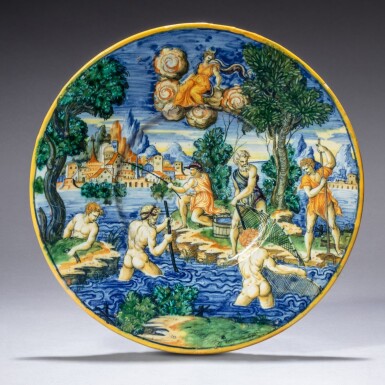
Italian, probably Urbino or possibly Pesaro, circa 1540-1555
An istoriato plate
Estimate
12,000 - 18,000 EUR
Lot Details
Description
Painted with the Goddess Luna illuminating the night sky for the fisherman, in blue, brown, orange, yellow, white and near black, inscriben in blue on the reverse Di tutti la piu bass io son la luna / Ch[’]obscura seria sempre sen[z]a il sole/Frigida son benigna humida sola / Chi mi creo chi[’]o luca in notte bruna. The inscription translates as ‘of all, I am the lowest. I am the Moon who without the Sun will always be dark / I am cold, mild, damp and alone / He who created me wished me to be the light in the dark night’
On the reverse the Sackler inventory number in red 18.2.12.
Tin-glazed earthenware (maiolica)
28.2cm. diam; 4in.
Alfred Spero, London;
Cyril Humphris, London;
Arthur M. Sackler Collection (1913-1987);
His sale (part I), Christie’s New York, 13 January, 1993, lot 31;
Rainer Zietz, London;
Where acquired, in February 2010.
Washington D.C., National Gallery of Arts, Sixteenth-Century Italian Maiolica from the Arthur M. Sackler Collection and from the National Gallery of Art’s Widener Collection, 5 September 1982 - 2 January 1983, no. 59;
San Francisco, The Fine Arts Museum of San Francisco, Palace of the Legion of Honor, Italian Maiolica from the Arthur M. Sackler Collections, 1986-1988, no. 88.
The quality and manner of painting on this plate indicate it is a product of Urbino from the mid-sixteenth century. However, from about 1540, some Urbino-trained maiolica-painters, especially from the workshop of Girolamo di Lanfranco and later his son Giacomo, moved to the nearby city of Pesaro, which had become the capital of the Della Rovere Duchy of Urbino. A plate using the same print source, at Vila Viçosa, Portugal, is attributed by P. Bonali and R. Gresta, Girolamo e Giacomo Lanfranco dalle Gabicce (1987), no. XXIV, to Pesaro.
The print source that inspired the composition of this piece is probably the woodcut of Gabriele Giolito de' Ferrara 1534 ‘Luna’ where several elements of the composition and anatomy of the bodies is closely comparable (fig.1).
You May Also Like










